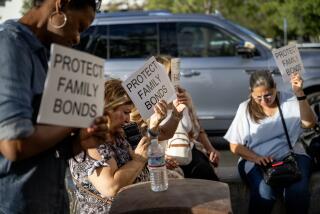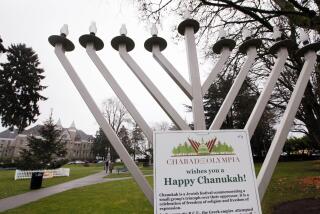Indian Historian Finds Parallels to Judaic Traditions : Spirituality: Creek researcher says the similarities to early Hebrew and Christian teachings are astonishing.
- Share via
NORMAN, Okla. — After an aged Indian woman, Bessie Snake, lost her husband when he and his two mules were killed by lightning while plowing, his younger brother dutifully married the widow.
That obligation is part of the religious traditions of the Delaware and some other tribes, matching a responsibility laid down in the biblical laws of ancient Judaism.
“The similarities of early native American religions and ancient Hebrew religion are astonishing,” says historian Duane Hale of the Creek tribe.
Hale, a researcher of the American Indian Institute at the University of Oklahoma, also notes congruent strains with early Christianity. Similarities include Indian expectations of a Christ-like benefactor, emphasis on communal sharing of everything, and emphasis on modesty by not calling attention to oneself.
“All American Indians were--and most are today--deeply religious and devoted to their belief in one supreme being,” Hale said in an interview. He discounted past characterizations of some old tribal rites as pagan.
“I don’t think it’s pagan to go up on a mountain and pray to try to get a vision,” he said, describing the “vision quest” of the Sioux and some other tribes. “It’s similar to what the biblical prophets did.”
Hale, 47, former co-chairman of the Department of Navajo and Indian Studies at Navajo Community College in Arizona and now with the university’s institute here, researches and writes tribal histories.
Since 1983, he has completed them for six tribes. He also conducts training workshops to help Indians across the country learn how to preserve tribal lore. Participants have come from about 200 of the nation’s 300 recognized tribes.
Thirty-seven of them have tribal headquarters in Oklahoma, which remained mostly Indian territory until 1907. The university’s Western History Collections library is considered the best on the plains tribes.
Because Indians generally have depended on handing down their religious traditions orally, “there’s a great danger they will be lost,” Hale said. “In many cases, they have been.
“There are not enough Indian histories. Many of the elders are dying, and I try to teach them to write their histories. Some are beginning to record it and put it in locked files only for the tribe.”
Although Indian religion sometimes is portrayed as highly distinct from biblical faith, Hale sees definite resemblances, judging on the basis of his advanced biblical studies as well as firsthand inquiries into Indian religion.
“Christianity and early Indian religion have been so interwoven that it is often difficult now to tell which came first for them,” Hale said. Of 1.4 million U.S. Indians, most are Christians but many also retain tribal insights, he said.
The Native American Church, which combines both Christianity and native religion, stemmed from the “ghost dance” religion started in the 1890s by a Paiute Indian from Nevada, preaching return of the buffalo and Christ to lift up the downtrodden.
“It spread like wildfire,” Hale said, adding that it uses the hallucinogenic peyote bean “as a sacrament,” which also is used in a “limited way” in some other tribal religions.
He said these also make extensive use of chants, the drum, the four directions, the circle, the smoked pipe and smoke from burning cedar waved about by a feather to ward off evil.
However, religious details vary from tribe to tribe, and often remain obscure, since there were no reliably balanced accounts of Indian concepts for the first 100 years of contacts with Europeans, he said.
On how he determines what religious elements are originally Indian, he said: “I only accept what the elders tell me is true. Some of it possibly came from back there in the seed of missionaries to some degree. At this point, nobody knows absolutely.”
More to Read
Sign up for Essential California
The most important California stories and recommendations in your inbox every morning.
You may occasionally receive promotional content from the Los Angeles Times.













